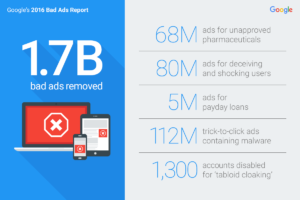
Last month, Google revealed that it had removed 1.7 billion ads over the course of 2016. You read that right — one-point-seven-billion! This number has increased astronomically since 2015 when Google removed a pithy (in comparison) 750 million ads. This information was released in Google’s annual “Bad Ads” report. Before you get up in arms about the free web and censorship, Google has this to say about bad ads:
But bad ads can ruin the online experience for everyone. They promote illegal products and unrealistic offers. They can trick people into sharing personal information and infect devices with harmful software. Ultimately, bad ads pose a threat to users, Google’s partners, and the sustainability of the open web itself.
Which ads are removed?
Google doesn’t remove ads willy-nilly. It takes down ads that break its rules and ones that seek to deliberately mislead or harm users. Of the 1.7 billion ads removed, 112 million of them were ads that downloaded malware on users’ devices when clicked; 80 million ads that purposely misled users in order to get clicks; 68 million ads for unapproved pharmaceuticals, such as weight-loss scams; five million ads for predatory payday loans; and 1,300 ads for ads that posed as legitimate news sources but weren’t.
Payday Loans
Payday loan ads have long been a thorn in Google’s side. In order to protect its users from falling victim to outrageous short-term loan scams, Google now prohibits and removes any payday loans that require borrowers to repay the full loan plus interest within 60 days. It also bans ads with APR rates of 36% or higher. Thanks, Google!
Tabloid-Cloaking
The shady technique of posing as news organizations to get traffic just to sell products or that spread false information is now called tabloid-cloaking. Google doesn’t want you to be duped into believing lies or clicking on a story just to be pitched a skincare product. As we discussed awhile back, “fake news” has become an increasing problem in the U.S. and globally. In an effort to stem this tide, Google took action against 340 of 550 sites reviewed for violations and banned nearly 200 publishers from the AdSense network. We appreciate Google’s effort in putting a stop to this harmful method.
Self-Clicking Ads
These buggers are a huge problem on mobile. Have you ever been reading an article or perusing a site on your phone when all of the sudden you’re taken to your app store and a strange app wants to be downloaded? This is most likely the result of a self-clicking ad contained on the page you were reading. It’s frustrating at best, and eerie at worst. Google agrees and removed 23,000 of these bad ads.

